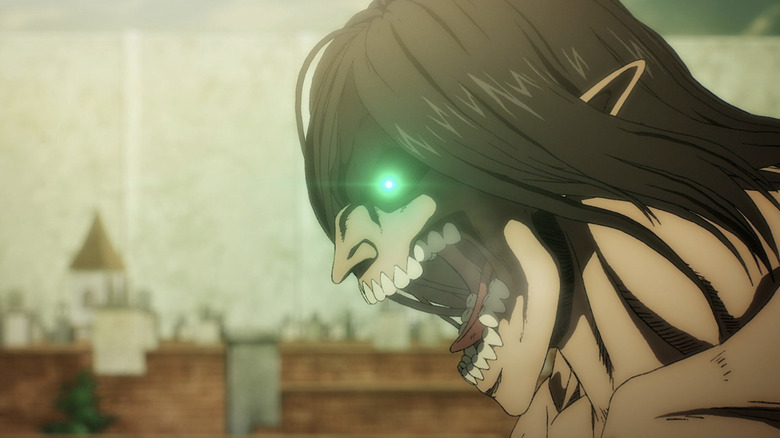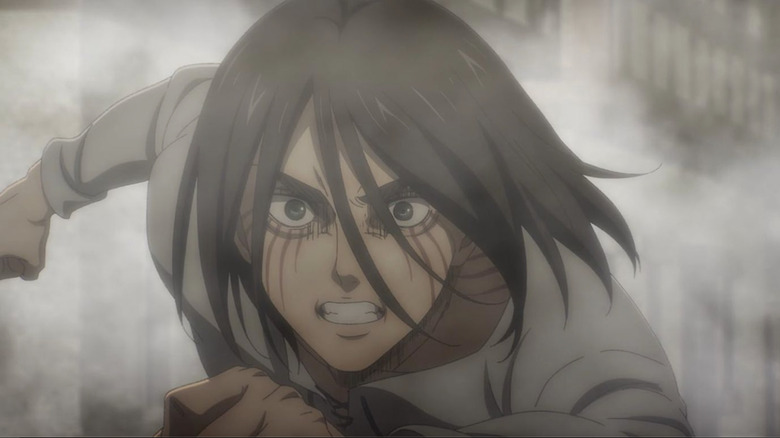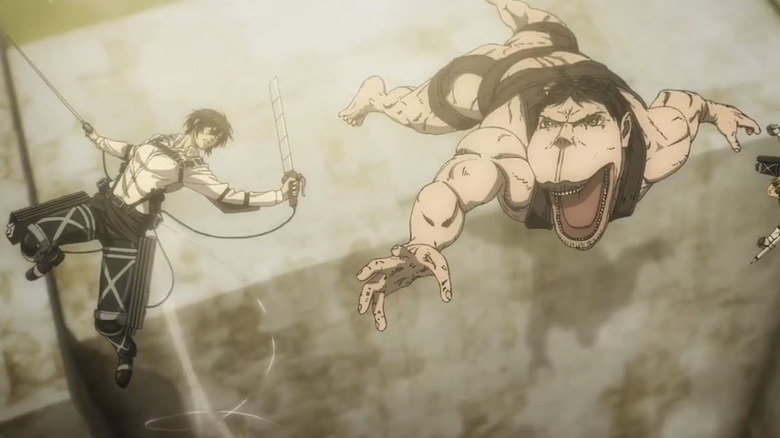Attack On Titan's Final Season Featured One Of The Series' Most Difficult Bits Of Animation
The final season of "Attack on Titan" has been one of an anime's most exciting and anticipated last runs in recent memory. The adaptation of the popular manga by Hajime Isayama has received widespread critical acclaim for its story, world-building, and characters. The mystery behind the titular titans and main character Eren Yeager's ability to transform into one had driven much of the anime's narrative up to the last two seasons. In typical "Attack on Titan" fashion, the ending of season 4 would feature a massive twist that upended the characters' beliefs on the state of the world and themselves.
Originally animated by WIT Studio, "Attack on Titan" would soon find itself a new animation studio to bring the final season to life. Enter Studio MAPPA, an animation studio responsible for many of the more popular Shonen in recent memory, such as "Jujutsu Kaisen" and the upcoming anime adaptation of Tatsuki Fujimoto's "Chainsaw Man." MAPPA would bring a whole new style to the final season of "Attack on Titan" while still honoring the art style and direction of not only the previous animation studio to work on the series but the artwork of series creator Isayama as well.
MAPPA would find themselves challenged by the end of "Attack on Titan" and some of its most significant moments in the manga, with one animator from the studio referencing Eren Yeager's mind-blowing moment in one of the later episodes as one of the most difficult to animate.
Frozen in time
Unlike the usual challenges of animating a Shonen, which involves choreographing and translating an intense fight from a manga page onto the screen, this specific episode of "Attack on Titan" presented a different challenge entirely. Featured in the series' second part of the final season, Eren Yeager attempts to establish a connection with his brother Zeke to start "The Rumbling," a massive event that the series has been building up to.
However, a well-timed shot from sharp-shooter Gabi stops Eren in his tracks, sending his head flying. What follows in the episode is what feels like time freezing after the shocking turn of events, with viewers given every angle of the battlefield from all the character's perspectives the moment it happens. In a behind-the-scenes video, Yuichiro Hayashi, the animation director for the final season of "Attack on Titan," described the process of bringing this scene to life as especially difficult:
"Actually, that scene is where I invested most of my energy. Eren's head gets chopped off... The whole sequence is like a series of slow-motion clips. In that scene, there is a moment as if time stops after his head flies off. When I read the manga, I didn't realize time had stopped. That's because manga is a single drawing. But even in anime, it's quite difficult to hold time, and mostly they just hold the frame by separating A cell and B cell. I thought it's difficult to express it with just a single drawing."
Properly expressing stillness
As difficult as it is to express the stillness of time in animation, Yuichiro Hayashi would figure out a way to accentuate the crucial moment in the anime. Hayashi described his solution as such:
"I decided to express the still moment by using smoke that fills the screen during the battle. The smoke is filling the air, but then... when time stops, the cloudy sky becomes totally clear. Like a clear winter air. That's how I made the contrast. Also, I used the dust around by making it look like the dust stood still in the air. We tried all kinds of stuff in that."
The intricate process of bringing a manga to life becomes more appreciated when you discover the work that goes into a single scene, especially like the one described earlier. While there is always praise for the action-packed moments for their crisp and visceral feel, the quieter moments can be just as challenging for an animator. The frozen-in-time calm before the storm in "Attack on Titan" is a perfect example of a reflective moment as tricky to animate as any fight scene and the creator's dedication to doing the source material justice.


